Halifax Harbour is one of several that claim to be the second largest natural harbors in the world. Other contenders include Port Jackson at Sydney in Australia, Cork Harbour in Ireland, and Poole Harbour in the UK. However, Halifax Harbor is most definitely home to Canada’s largest military base with respect to posted personnel, and also is home port for Canada’s Atlantic fleet.
Trip highlights from our September 17th, 2016 dinghy tour of in Halifax Harbour, Nova Scotia follow. Click any image for a larger view, or click the position to view the location on a map. And a live map of our current route and most recent log entries always is available at http://mvdirona.com/maps
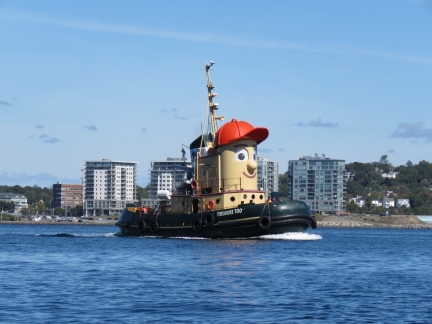 |
Theodore Too
Position: -63 34.16, 44 38.98
On a dinghy tour through Halifax Harbour we passed Theodore Too returning from a tour of the “Big Harbor”, modeled on Halifax Harbour.
|
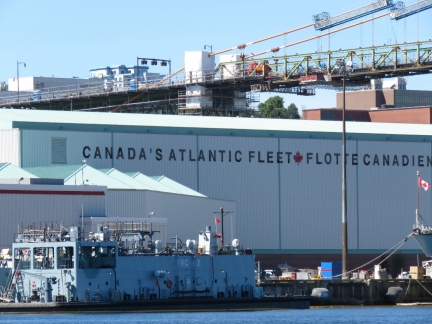 |
CFB Halifax
Position: -63 34.84, 44 39.67
CFB Halifax is the largest Canadian Forces Base (CFB) with respect to posted personnel and is home to Canada’s Atlantic fleet. The base evolved from HMC Dockyard Halifax that the Canadian Government acquired from the Royal Navy following the 1906 withdrawal of British Military forces from Canada.
|
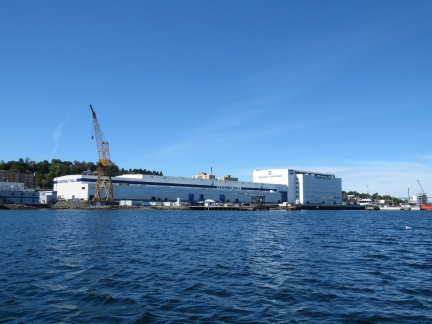 |
Halifax Shipyard
Position: -63 35.46, 44 40.05
The massive buildings at Halifax Shipyard. The yard can build new boats up to 120m long and repair ships up to Panamax size. Halifax Shipyard’s Assembly and Ultra Hall facility is 157ft (48 m) high at its highest point and a quarter mile (407 m) long, making it the largest single building for constructing ships in North America.
|
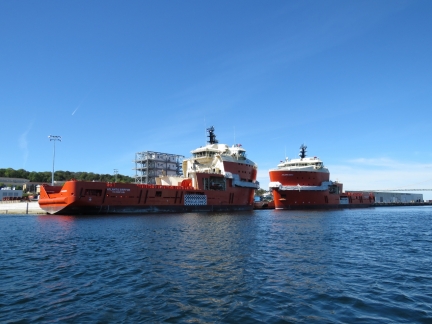 |
Atlantic Griffon
Position: -63 35.86, 44 40.29
The 4200-ton Platform Supply Vessels Atlantic Griffon and Atlantic Shrike at Halifax Shipyard. The two ships were built in Romania, disassembled and shipped to Halifax where they recently arrived and were reassembled. Presumably the customs duty payable on ship parts plus the disassembly and reassembly costs, is less than that for a complete ship, which we’ve read can run to 25%.
|
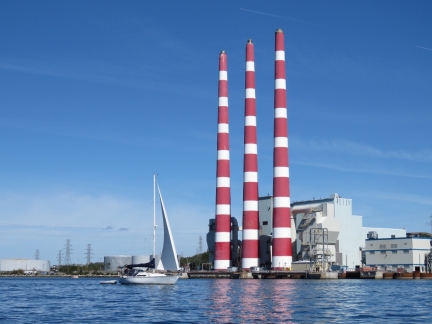 |
Generating Station
Position: -63 35.98, 44 40.35
A sailboat passing in front of the distinctive cooling towers at the Tufts Cove Generation Station on the east side of Halifax Harbor.
|
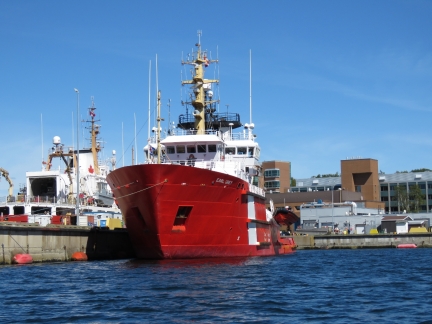 |
Earl Grey
Position: -63 36.86, 44 40.83
The Canadian Coast Guard vessel Earl Grey at Canadian Coast Guard Base Dartmouth. The base relocated about three years ago to north of the A. Murray MacKay bridge from a location close to downtown Dartmouth. The Earl Grey performs a variety of roles, including light ice-breaking and buoy tending.
|
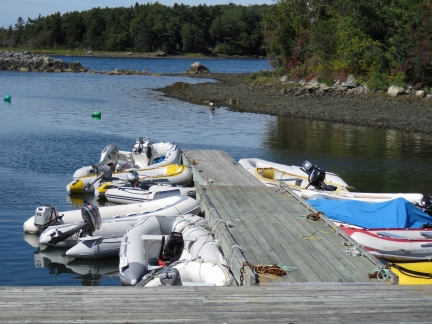 |
Dartmouth Yacht Club
Position: -63 36.62, 44 42.06
The tender moored at the Dartmouth Yacht Club while we go to lunch. The yacht club members warned us that the area was an industrial park with not much to see, but we had a nice walk and enjoyed our lunch stop.
|
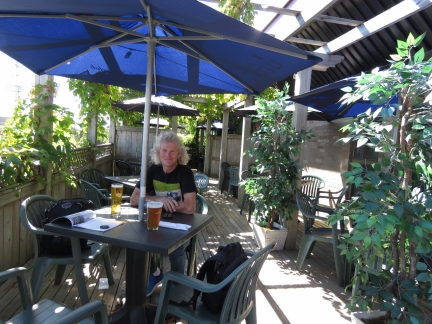 |
Old Port Pub
Position: -63 36.72, 44 42.24
We had a good lunch on the patio at the Old Port Pub about a ten-minute walk from the Dartmouth Yacht Club.
|
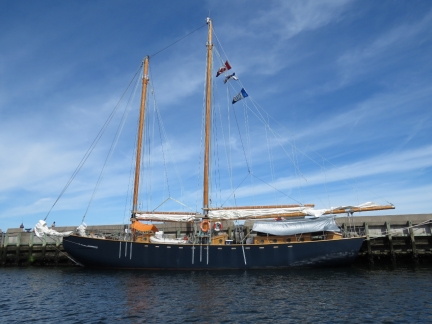 |
Katie Bella
Position: -63 40.24, 44 42.79
The wooden schooner Katie Bella was hand-built in Stewiacke, Nova Scotia, the first ship to be built along the Stewiacke River in living memory. Cousins Evan and Nick Densmore spent five years building the 24-metre wooden ship, which they tested along the Eastern Seaboard this winter.
|
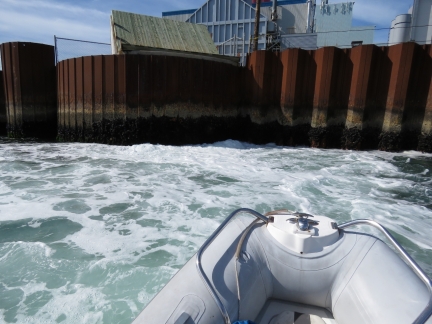 |
Outflow
Position: -63 35.71, 44 40.49
The fierce outflow from the Tufts Cove Generation Station. The water temperature was 69F near the source, compared to 61F in the rest of Halifax Harbour.
|
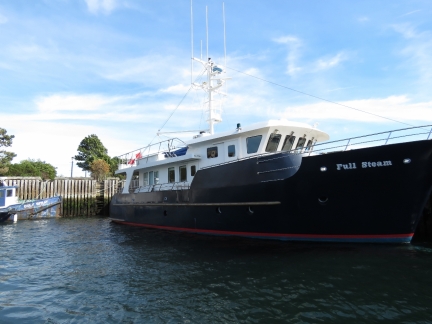 |
Full Steam
Position: -63 34.15, 44 39.80
Full Steam is one of about fifteen Cape Horn ocean passage-capable steel trawlers ever made before the company went out of business. This one probably is a Cape Horn 58.
|
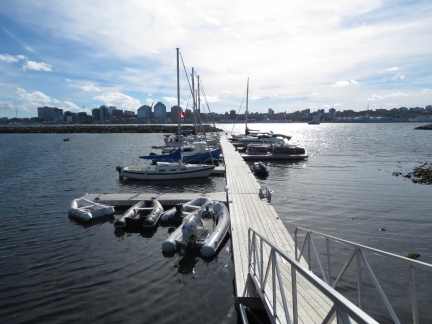 |
Kings Wharf
Position: -63 33.90, 44 39.81
Tied off at Kings Wharf to walk around Dartmouth.
|
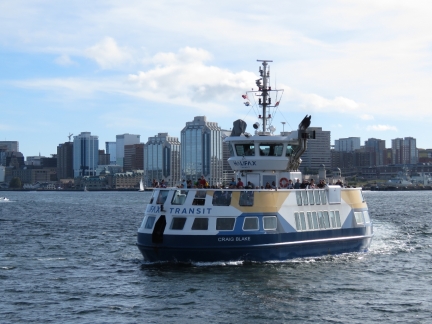 |
Craig Blake
Position: -63 34.23, 44 39.84
Craig Blake coming into Dartmouth Ferry Terminal from Halifax.
|
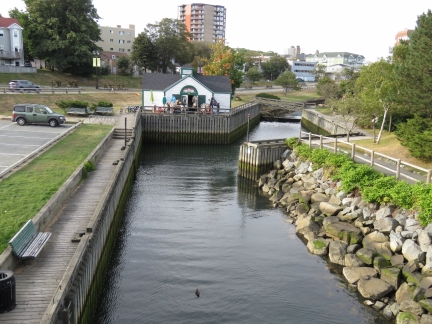 |
Shubenacadie Canal
Position: -63 33.86, 44 39.90
Looking up the historic Shubenacadie Canal built to facilitate transportation between Halifax and the agricultural, timber, and coal producing areas of Northern Nova Scotia and the Annapolis Valley along the Bay of Fundy. The canal was completed in 1861 after several construction delays, but closed in 1871 due partly to the construction of a fixed railway bridge that severely impeded steamship traffic. Three of the nine locks have been restored to preserve their unique blend British and North American construction techniques, but only one is operational.
|
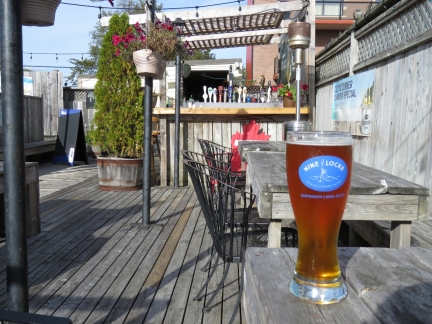 |
Celtic Corner
Position: -63 34.11, 44 39.88
An ultra-local craft brew on the rooftop deck at the Celtic Corner Public House in Dartmouth. Nine Locks brewery is about 2.5 miles away and named for the nine locks on the historic Shubenacadie Canal.
|
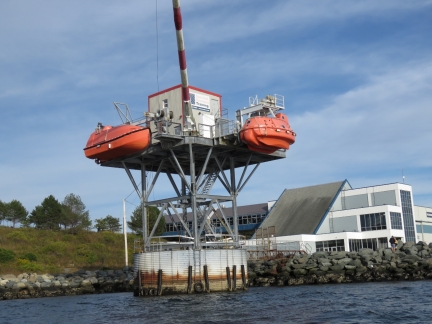 |
Survival Training
Position: -63 33.06, 44 38.95
Two life rafts mounted on hoists at the Survival Systems Training school. That must be exciting to be inside when they drop.
|
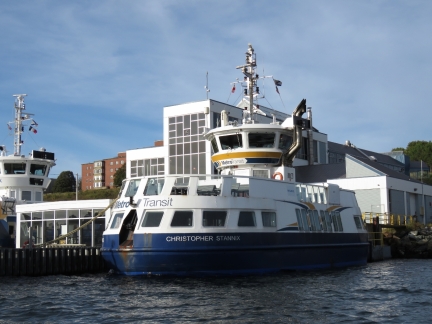 |
Christopher Stannix
Position: -63 32.97, 44 38.91
The ferry Christopher Stannix at the Woodside Ferry Terminal on the terminus of the southern run between Dartmouth and Halifax.
|
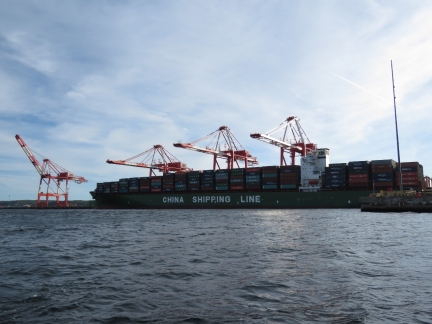 |
Port of Halifax
Position: -63 33.67, 44 37.97
The top five imports by volume in the Port of Halifax are 1) Machinery and Equipment, 2) Clothing 3) Furniture 4) Manufactured Goods and 5) Metal (Iron and Steel). The top five exports are 1) Wood pulp, 2) Newsprint and Paper, 3) Seafood, 4) Machinery and Equipment, and 5) Vegetables. Note that four of the five exports are raw material rather than manufactured goods.
|
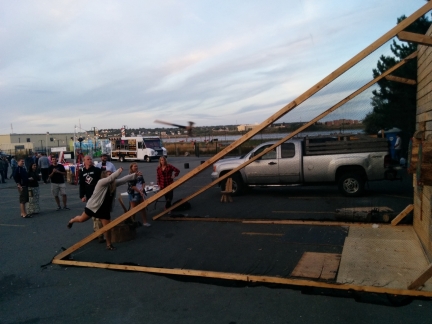 |
Axe Throw
Position: -63 34.17, 44 38.64
After returning from our dinghy tour, we walked out for dinner. That person really is throwing a long-handled axe at the Halifax Oktoberfest. The wall they’re throwing the axes into is on the edge of the grounds with no safety area behind it. So if someone misses the wall, it could be a big problem for an unrealizing passerby.
|
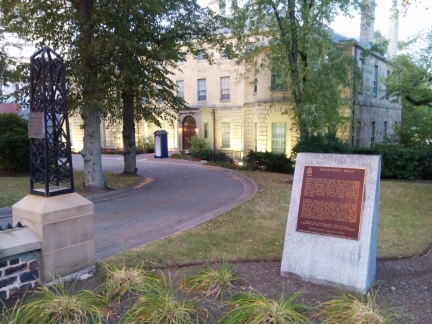 |
Government House
Position: -63 34.28, 44 38.53
Government House is the official residence of the Lieutenant Governor of Nova Scotia, as well as that in Halifax of the Canadian monarch. The building was completed in 1805 and is a National Historic Site.
|
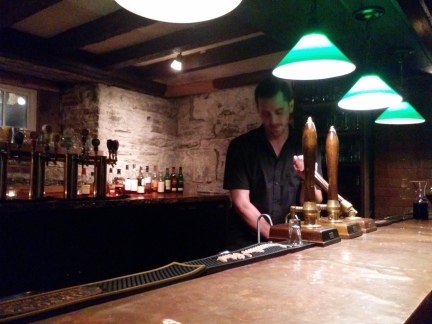 |
The Henry House
Position: -63 34.23, 44 38.43
Jennifer has been pining to visit the Granite brew pub in Halifax since first arriving into Nova Scotia two months ago. The Granite Brewery, established in Halifax in 1985, opened a Toronto brew pub in 1991 that was a favourite haunt of the IBM Toronto Lab compiler and database teams that we were worked on. James had actually been to the Granite brew pub in Halifax at The Henry House, a National Historic Site, but Jennifer hadn’t. Unfortunately, the Granite has since moved its brewery away from The Henry House and dropped its brew pub license. But The Henry House still carries Granite on tap and their Best Bitter tastes as good as ever.
|

|
Click the travel log icon on the left to see these locations on a map, with the complete log of our cruise.
On the map page, clicking on a camera or text icon will display a picture and/or log entry for that location, and clicking on the smaller icons along the route will display latitude, longitude and other navigation data for that location. And a live map of our current route and most recent log entries always is available at http://mvdirona.com/maps. |

Since several harbors claim to be the 2nd largest natural harbor in the world, who is the first? And is it big enough that no one challenges it’s claim?
There are so many exuberant claims from civic leaders and there are so many different measures of “largest” that its really hard to say with certainty. As an example Sydney is listed both as the a contender on the second largest list but also as the largest.
It’s hard to get a single definitive answer on which harbor is the largest.